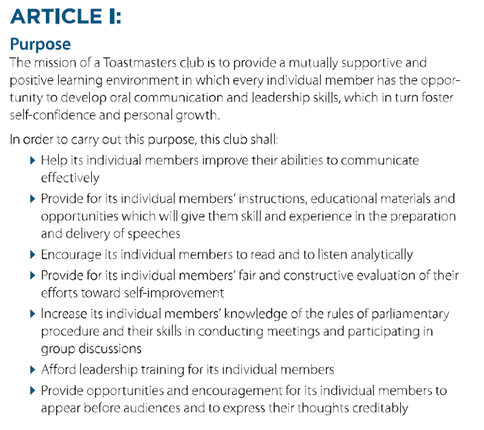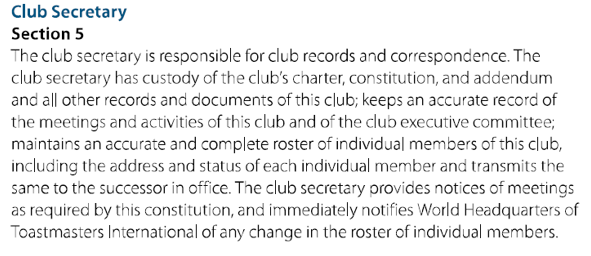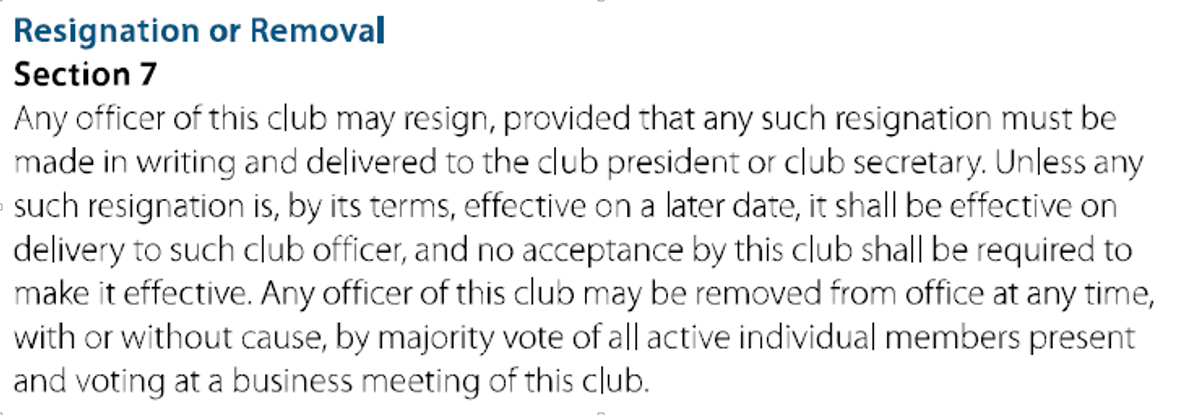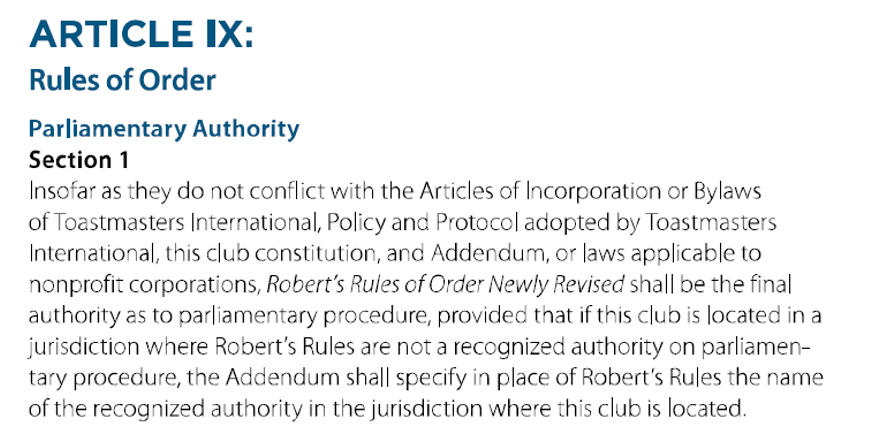 A Compliant Club is a Strong Club The TMI Club Constitution has evolved over nearly 100 years to provide a framework of education, governance and leadership for every Toastmasters club throughout the world. Successful clubs understand and follow their Charter, whilst others choose to ignore it or worst still, do not know it exits. To the readers of this blog unaware of the wisdom of the TMI Club Constitution, let us highlight some of the articles/sections that influence decision making, as a club coach and/or club officer. I recommend that a current copy of the Toastmasters International Club Constitution be at hand when reading this blog entry. This is freely available from the toastmaster International. Put "TMI Club Constitution" into your search engine and the document will be found. Article I: As a club officer we not only have an obligation to teach better listening, thinking and speaking but also meeting procedures. “Where Leaders are made” is the TMI logo advertised to the world. If we are to encourage members toward leadership, we as club officers need to teach the “rules.” What are their obligations and rights as individuals, what is the Constitution and what are standing orders? How can these “rules” benefit them as members and ultimately their club? What is the difference between an alliance to District and an allegiance to TMI WHQ? The more comfortable members become at understanding where they stand as members, club officers and within their respective District, the more club and District roles are sought after and filled. Article II: This relates to membership. The Constitution states every club is a private association inviting membership through prospective members completing a Club Application Form. Members are required to be voted in. This inspires respect in becoming a Toastmasters club member. In addition it can be argued, when a member is voted in, they can be voted out if they are found to breach of the TMI Code of behaviour. Formal inductions is an experience to new members. It is a sign of professionalism and discipline looked for in any organisation. Formality does not scare those who are seeking professionalism and the discipline to improve their own development. These members are usually the ones that contribute the most to a clubs success. Article III: l members are equally responsible to ensure the club complies with the TMI Club Constitution as well as having an educational program in which they contribute and participate. As a club officer your responsibilities do not change but are enhanced by the role you have been elected to perform. In a significant number of clubs, member rights and responsibilities are not included in the education program nor in District and or through Club Officer Training (COT). Without ongoing reminders of the TMI Club Constitution and the benefits of following these tested rules, clubs will do what they have inherited to do – some have never been taught the “rules!” Constitutional training appears to be a club responsibility as Districts may not acknowledge there is an issue, nor does it appear to be a TMI requirement on District. “Remember the member” is a catch phrase used consistently in the District COT. Regretfully this philosophy does not appear to be applied universally across our organisation. Article VII: The most overlooked role of importance is that of the secretary, more specifically it is the recording of minutes of club business and the maintenance of accurate records. Not every club records and files a set of signed minutes yet this is the only legally accept transcript of club business. Some argue that agenda provide proof, this is not so. An agenda is the intention of what is to occur whilst a set of minutes is what did occur. When signed by the chairman of the business session they are deemed to be true and correct and acceptable in a court of law. How does the member benefit from accurate records?
Executive Committee To be elected onto the committee as a member you acknowledge you have a role to fulfil for a nominated period (6 or 12 months). You also know the decisions, direction or recommendations made by the executive are required to be approved by the members (ratified) as they (the members) share and are ultimately responsible for all decisions made. The question has been raised how do you ratify a set of executive minutes? Ratification consists of the following steps:
Article VI: The constitution recognises the authority of individual members by Section 7. All members share an equal responsibility in running a club and it is the individual executive members who help steer the club in the direction the members wish to travel. The executive do not dictate what is to happen, do not hide mail or information or ideas that members may need to decide on or may benefit the members. Where there is evidence of an officer working outside the Constitution members may remove that member from office. The authority given the members by the Constitution is very powerful, as it allows any officer to be removed by vote of the members for any or no reason. Leaders in successful clubs teach this authority to their members as a tool to ensure individual officers do not follow individual agendas. The rotation of club officers is promoted by TMI. The organisation recognises more members performing club officer roles leads to more respect for the roles and offers an opportunity to “new blood” to taste the leadership path, test old ideas and put new ideas forward. If the same members continually perform the same club officer roles, a club stagnates into a social club without drive, direction, and real opportunities which is what young members look for. The end result is new members are hard to come by and retain. Old clubs with old (aged) members find it difficult to attract young (aged) new members, as these new potential members do not see the dynamics that they are looking for. The club President is one club officer position that must change. Unfortunately clubs who are not aware of Section 9, have presidents who are either ignorant of the Constitution by remaining in the President role year after year, or blatantly ignore the requirement, because of self-interest or that they are comfortable in the role and claim “no other member can do it better”. A successful club promotes new members into officer roles as it provides an opportunity to broaden the perspective of the officer and brings a new dynamic to the club with new ideas thus keeping a club vibrant and fresh. Standing orders (rules of meeting procedures) used by a club should be according to the recognised authority of the country you are in. For example if your club was in China you would be using the Chinese recognised authority. If our club was in America it would be Roberts Rules, however as we are in Australia it is Renton. This authority is recorded in the clubs Addendum.
A club teaching meeting procedures by conducting business sessions including training motions is not only fun but another tool to encourage and teach leadership. It does not turn members away, which is the usual excuse in fact it, encourages members and provides leadership confidence to stand for those roles outside Toastmasters benefiting the community, their club and District. In some cases clubs gain members simply because they teach meeting procedures. If we combine speaking and knowledge of meeting procedure we have a member who has the tools to be a leader. If we only provide good speaking skills, we are only half a Toastmaster. If we relate this situation to 2 football clubs - one teaches great ball, running and kicking skills but never wins a game because their players are fouled out for not knowing or playing within the rules, versus the second team who also teaches the basic skills but ensures their players know all the rules, It may not win all the time but it does most of the time. The TMI Club constitution was the document your club founding members signed to form the club. If you interpret this document and your club remains compliant to the document then the club is working within a framework of success. It is true to say that every club needs members but equally, every member needs a club. The constitution provides one and if a club erodes away this framework by non compliance that club is dismantling the formula of success.
3 Comments
31/8/2019 02:44:15 pm
Being a member of a club is not an easy thing. The fact that you are working with other people means that you have responsibilities. If you are not okay with communicating with other people in your group, then you will never be able to function ideally. If you ask me, every member of a group needs to familiarize themselves with who they are about to work with. Being a member of this club holds a lot of responsibilities and pride.
Reply
1/12/2020 04:05:06 am
Thanks for explaining that clubs need to stick to their constitution because it provides information on the roles that everyone plays. My husband would like to buy a private club. I'll suggest that he find a consulting service to help him keep track of everything.
Reply
Charmaine Thomson
10/3/2021 01:35:38 pm
Hi Olaf
Reply
Leave a Reply. |
Details
AuthorOlaf Schubert DTM ArchivesCategories |






 RSS Feed
RSS Feed